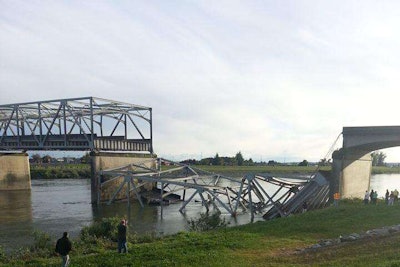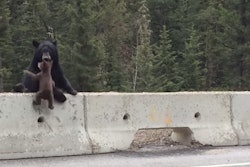 Washington State’s I-5 bridge that collapsed into the Skagit River in May 2013 is an example of the need for infrastructure investment. (Photo: modified from Cole Wagoner / Twitter)
Washington State’s I-5 bridge that collapsed into the Skagit River in May 2013 is an example of the need for infrastructure investment. (Photo: modified from Cole Wagoner / Twitter)The “crumbling infrastructure” in the U.S. threatens global competitiveness as well as job and economic growth, business leaders say.
A survey conducted by Building America’s Future (BAF) and the U.S. Travel Association found that more than three-quarters of respondents said the state of the transportation infrastructure in the U.S. puts the nation at a competitive disadvantage compared to other countries, while more than 25 percent say the U.S. is at a “strong disadvantage.”
BAF and the U.S. Travel Association released the findings this week at a press conference.
BAF co-chair and former Transportation Secretary Ray LaHood called on lawmakers to find a solution to fund infrastructure repairs.
“It is imperative that Congress takes action to fix America’s crumbling bridges and potholed roads so that the United States can once again be economically competitive on a global scale,” LaHood said. “Six of the world’s busiest ports are now in China—and none are here in the U.S.”
He added that the nation is losing its competitive edge, noting that the U.S. no longer ranks in the top 10 in the world for aviation.
“America invented aviation, and now the U.S. ranks 18th in the world behind such countries as Barbados and Panama in the industry,” he continued. “It’s shameful, and must be remedied.”
U.S. Travel Association President and CEO Roger Dow pointed to a the increase in congestion that will occur without action.
“Within a decade, most of our top 50 airports will experience Thanksgiving-like passenger congestion every week,” Dow said. “Labor Day traffic levels will soon be a regular reality on our busiest highways. If we’re going to fully capture the economic potential of travel, we must address our infrastructure, and do it now.”
The survey also found that 87 percent of respondents believe America’s infrastructure is either in “fair” or “poor” shape and needs a great deal of improvement, while 12 percent think it is in “pretty good shape” and needs some improvement. Only 1 percent said it is in good shape and needs no improvement.
According to the survey results, 74 percent of respondents said the quality and reliability of infrastructure is extremely important to the success of their business or travel destination, though 76 percent said they do not believe the current state of U.S. infrastructure is positioned to respond to the competitive demands of increased travel over the next 10 to 15 years.
Most respondents (93 percent) said the nation’s infrastructure needs greater investments for maintenance and upgrades and all funding options should be considered.
The current highway bill, MAP-21, will expire on September 30. Lawmakers and national leaders are working to create a new bill that provides solutions for greater infrastructure investment.
President Barack Obama earlier this year proposed a $302 billion, four-year bill, which Transportation Secretary Anthony Foxx sent to Congress last month. Earlier this month, the Senate Environment and Public Works (EPW) Committee approved a six-year highway bill. And on Thursday, the first water infrastructure bill since 2007 was sent the President Obama’s desk.
However, Congress will need to find a solution for surface transportation infrastructure before MAP-21 expires. The Highway Trust Fund, which provides funding for most state and local highway and bridge projects, is expected to run out of money in late August. If the HTF becomes insolvent, the U.S. DOT would have to delay or stop payments to state and local agencies, new transportation projects in some states would not start and 700,000 workers would lose their jobs.












